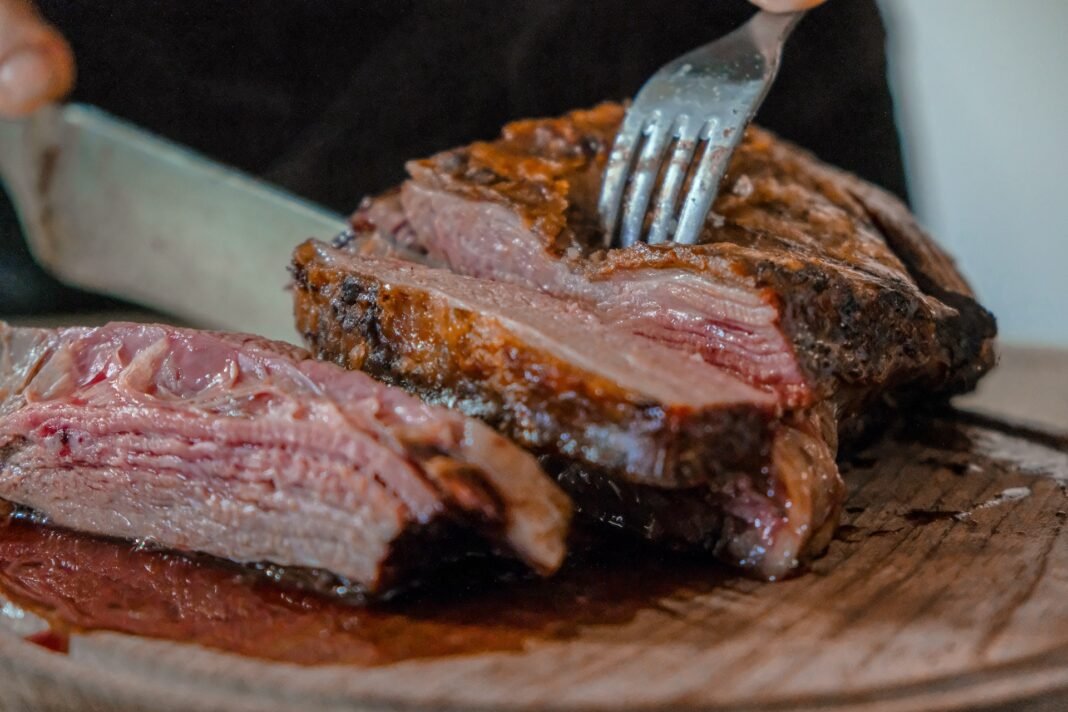Grass-fed meat offers a richer, beefier flavor from the animal’s lifestyle of natural grazing on nutrient-rich grasses. It can cook up to 30% faster than grain-fed steak, so it’s important to use lower heat and check your food thermometer more often for a tender result.
It’s Better for Your Gut
Grass-fed beef has different fat compositions, which is better for you than the grain-fed beef in most supermarkets. In addition, grass-fed meat contains 3-4 times more omega-3 fatty acids, which are anti-inflammatory and crucial for healthy cellular function. Omega-3 fatty acids also help lower blood pressure and improve cardiovascular health.
Choosing a lean cut like flank steak is a great way to maximize the nutritional benefits of this type of meat. Ounce for ounce, grass-fed flank steak has fewer calories and more protein than a porterhouse or ribeye.
Another health benefit of choosing grass-fed meat is that it contains less saturated fat. Unlike the saturated fat in grains, which raises cholesterol levels, the saturated fat found in grass-fed meats is monounsaturated and can lower cholesterol.
Whether vegetarian, vegan, or omnivore, red meat can be an important part of your diet. But it is important to choose wisely and opt for a grass-fed source whenever possible. A diet combining grass-fed meat with plenty of organic vegetables can help you achieve optimal health and vitality.
It’s Better for the Environment
A grass-fed diet is more sustainable than raising cattle on a large grain farm, which can deplete soil nutrients. According to dietitian Veronica Rouse, grass-fed meat also contains fewer calories than grain-fed beef and has healthier fat profiles—including more omega-3 fatty acids and CLA.
Grass-fed beef has more healthy antioxidants than grain-fed meat and may have more heart-healthy monounsaturated fats. Look for local grass-fed beef—bonus points if it’s organic and from a small, independent farm. Many outstanding internet sellers will deliver high-quality, locally raised, grass-fed meat to your doorstep.
Across all eight cuts analyzed, increased media attention to climate change did not appear to affect grass-fed premiums. Still, increased media information on taste was associated with higher premiums for sirloin and flank steak. A 1% rise in real annual disposable income was associate with higher premiums for a ribeye steak and short ribs but lower premiums for rump roasts. When assessed in the pooled regression framework, the effect on rump roasts was heterogeneous and not statistically significant.
It’s Better for Your Heart
Grass-fed meat is richer in omega-3 fatty acids and lower in omega-6 fatty acids, according to a March 2010 Nutrition Journal study. These fats are “heart-healthy,” reducing your risk of heart disease and inflammation, which can lead to chronic diseases like arthritis.
Moreover, the protein in grass-fed beef is easier for your body to digest. It also contains antioxidants, such as glutathione and superoxide dismutase, which fight oxidative stress on your cells and keep you from getting sick.
Flank steak, cut from the cow’s abdominal muscles, is an up-and-coming cut that can be grilled or pan-fried. Its long, flat shape soaks marinades well, producing a mouthwateringly bold beef flavor. Remember to cook a flank steak to medium-rare when grilling for a juicy and tender result. Then, cover it with foil and let it rest for a few minutes so the juices seep back into the steak. Add it to salads, sandwiches, or a stir-fry to increase your protein intake with a lean but satisfying meal. You can also try it sliced thinly over arugula with zesty vinaigrette or tucked into a panini on rustic bread with roasted peppers and basil.
It’s Better for Your Bones
A cow’s diet greatly impacts the flavor and health of its meat. Grain-fed cows get fatter, but their meat is less tender and has a much blander taste. By contrast, grass-fed cows produce leaner cuts that are boldly flavor and healthier.
Grass-fed beef also has higher levels of Omega-3 fatty acids and conjugated linoleic acid (CLA), a potent antioxidant that reduces inflammation. A 2010 article in Nutrition Journal found that CLA may help protect against heart disease and cancer, while another study published in 2019 found that it may lower your risk of developing breast cancer.
However, one of the reasons why grass-fed steaks are sometimes perceive as dry or chewy is that they have a different level of marbling than grain-fed cuts do. While adding a pat of butter after cooking a steak helps make it juicier, that doesn’t address the fact that the moisture in the meat makes it tasty and juicy. To help retain the most moisture possible, we recommend using lower heat and shortening your cooking time when preparing your steaks.
It’s Better for Your Tastebuds
A diet based on natural grazing on nutrient-rich pastures yields beef with a more robust flavor than grain-fed animals. And that bolder beefiness also contains more beneficial nutrients, like vitamins A and E, conjugated linoleic acid (CLA), and heart-healthy omega-3 fats.
Flank steak is a lean cut from the bottom belly section of the steer that’s best when marinated and grilled or sliced thin for flavorful fajitas.
If grilling isn’t possible, try baking or pan-searing your flank steak with a little high smoke-point oil to achieve a crisp crust and tender interior. Just cook it to a minimum of 145 degrees for food safety and optimal flavor.



